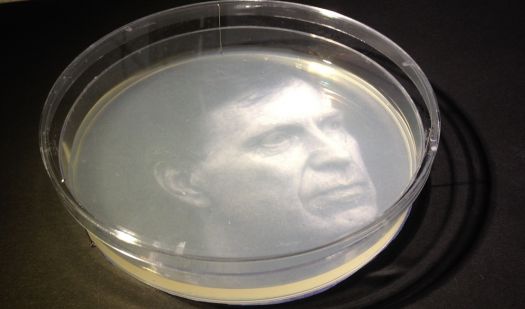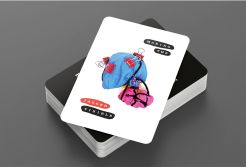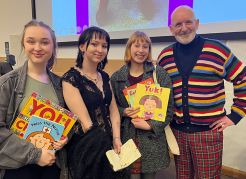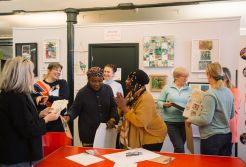Artists exhibit at Manchester Science Festival’s ‘A Grand Exposition’
25 October 2017
Jon Biddulph and Dave Griffiths from Manchester School of Art show their work
An artist’s self-portrait using microbes from his own face, highlighting the scale and complexity of each person’s internal and external living environment, is one of many works from Manchester Metropolitan University staff on display at a special art exhibition at Manchester Science Festival.
Jon Biddulph’s Microbe Me features a photograph of the Senior Lecturer from Manchester School of Art overlaid with a microbial portrait cultured on an agar plate.
In conjunction with the exhibition, he conducted a workshop with a group of Science and Art students at Loreto Sixth Form College in Hulme assisted by two PhD Microbiology students and two BA Interactive Arts students from Manchester Metropolitan.
Plates with cultured microbial prints of the students' mobile phones, keys, and other personal objects gathered in the workshop will accompany the portrait in the exhibition.
The exhibit – revealing the normally invisible way humans, our possessions, homes and offices are part of the living environment – is part of ‘A Grand Exposition’ (27-29th October).
Art and science celebrated
With a nod to The Great Exhibition of 1851, A Grand Exposition is a three-day celebration of the region's diverse community of artists, makers and creative technologists.
Blending exhibitions, entertainment and demonstrations, the event offers a family-friendly sprawl of technological, science-orientated artworks, maker workshops for all ages, illuminated talks that explore the social and cultural impacts of science and technology, and all manner of science-themed live performances.
Biddulph’s work reflects his interest in the significance of the human microbiome, the complex community of microbes living in and on the body, and how this is part of the ubiquitous microbial world. Current research is revealing that the microbiome of the gut is linked to conditions such as obesity, cardiovascular disease, diabetes and mental health issues.
He also proposes an expansion of the popular visible perceptions of the terms ‘Nature’ and ‘Environment’ to encompass this invisible ecosystem.
Biddulph said: “This is the first time I’ve used microbiology in my work, however I have always been interested in people and spaces, gardening, nature (I grew up on a farm), science (particularly recently Microbiology), food and cooking - including weekly 'microbiology experiments’ with sourdough bread baking.
“This work is the first step in exploring the confluence of many of these separate interests. In this work the person is the environment and vice versa.”
Dave Griffiths - Microtopias
Also showcasing work at the event is Dave Griffiths, Senior Lecturer in Interactive Arts, who frequently observes scientific experts at work and aims to discuss the roles of critical culture and technology in making futures.
His Microtopias exhibition consists of works from Griffiths’ back catalogue that refer to the new possibilities of preserving and transmitting matter across deep timescales that were opened up by JB Dancer’s invention of microfilm in Victorian Manchester. Dancer combined existing instruments to project magic-lantern images through microscope lenses and expose miniature photographs.
Bauplan compresses thousands of snapshots of Griffiths’ entire body surface into a microfiche, a response to the post-humanist science movement which advocates technologies for storing the consciousness of dying humans to live in eternity in digital networks.
Extinction Event [GRB130313A] documents the detection of a gamma-ray burst by NASA astronomers in the form of a compressed ‘photograph’ of this epic event billions of years ago, depicted through data visualisations, human and computer-generated dialogue and the office of the observers. These sightings help astronomers to construct theories about the scale and form of the universe.
The work of two PhD students will also be on display. Gemma Latham displays an interactive piece that invites visitors to donate their biometric data to a growing textile pattern that responds to their physiology, while Alex Pearl exhibits a television set which produces sporadic pictures in response to incidental noise.
A Grand Exposition runs from Friday 27th-Sunday 29th October at Talbot Mill as part of the Manchester Science Festival.




